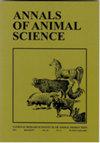The association of gene polymorphisms with milk production and mastitis resistance phenotypic traits in dairy cattle
IF 2.2
4区 农林科学
Q2 AGRICULTURE, DAIRY & ANIMAL SCIENCE
引用次数: 0
Abstract
Abstract The aim of this study was to evaluate the association between gene polymorphisms (SNPs) and mastitis indicators and their relationship with milk production profitability in dairy herd. A functional analysis was also performed of five genes containing the studied SNPs and those located close by. DNA was isolated from the hair bulb of 320 dairy cows kept in three herds and SNP-microarray analysis was performed. The data on 299 cows was subjected to final statistical analysis using AI-REML method with one-trait repeatability test-day animal model and pedigree information using the DMU4 package. Five from 35 SNPs significantly associated with mastitis indicators or production traits and located within a gene or no more than 500,000 nucleotides from the gene were selected for the functional and economic analysis. A questionnaire was also developed to collect associated economic data of 219 cows from three herds, such as the value of milk production and direct costs incurred over three years; this allowed the gross margin, direct profitability index and direct costs incurred to produce one liter of milk to be determined, among others. None of the five studied SNPs were related to protein content. The rs110785912(T/A), found near CXCR4, and rs136813430(T/C), located in the TLR4 gene exon, were associated with lnSCC, while rs110455063(C/G), located near IGF-I, was associated with milk yield, fat and total solid contents. rs109421300(T/C), associated with fat/protein content ratio, as well as fat and total solid content, is located in the DGAT1 gene intron. rs41587003(A/C), located in the DLG2 gene intron, was associated with lactose content. The economic analysis revealed differences between the variants of the three tested SNPs. The T/C variant of the rs136813430(T/C) SNP was characterized by the highest gross margin, the highest direct profitability index and the lowest costs incurred to produce 1 liter of milk. The T/A variant of rs110785912(T/A) was related to low lnSC and was characterized by the highest direct profitability index. In turn, the C/C variant of the rs41587003(A/C) was related to the lowest level of lactose and the highest costs of milk production. It appears that rs136813430(T/C) may be the most promising of the tested SNPs for increasing the profitability of milk production. To our knowledge, it is the first effort to assess directly a correlation between the DNA polymorphism and economic output of a dairy enterprise.基因多态性与奶牛产奶量和乳腺炎抗性表型性状的相关性
摘要本研究的目的是评估基因多态性(SNPs)与乳腺炎指标之间的关系,以及它们与奶牛群产奶能力的关系。还对包含所研究的SNPs的五个基因和附近的基因进行了功能分析。从三个畜群中饲养的320头奶牛的毛球中分离出DNA,并进行了SNP微阵列分析。使用AI-REML方法对299头奶牛的数据进行最终统计分析,使用DMU4软件包对一个性状重复性试验日动物模型和谱系信息进行统计分析。从35个与乳腺炎指标或生产性状显著相关的SNPs中选择5个,这些SNPs位于一个基因内或该基因不超过500000个核苷酸,用于功能和经济分析。还编制了一份调查问卷,收集了三个牛群219头奶牛的相关经济数据,如牛奶生产价值和三年内产生的直接成本;这使得毛利率、直接盈利指数和生产一升牛奶的直接成本得以确定。五个研究的SNPs均与蛋白质含量无关。在CXCR4附近发现的rs110785912(T/A)和位于TLR4基因外显子中的rs136813430(T/C)与lnSCC有关,而在IGF-I附近发现的rss110455063(C/G)与产奶量、脂肪和总固体含量有关。rs109421300(T/C)位于DGAT1基因内含子中,与脂肪/蛋白质含量比以及脂肪和总固体含量有关。rs41587003(A/C)位于DLG2基因内含子中,与乳糖含量有关。经济分析揭示了三种测试SNP变体之间的差异。rs136813430(T/C)SNP的T/C变体的特点是毛利率最高,直接盈利指数最高,生产1升牛奶的成本最低。rs110785912的T/A变体(T/A)与低lnSC有关,并以最高的直接盈利指数为特征。反过来,rs41587003(A/C)的C/C变体与乳糖含量最低和牛奶生产成本最高有关。rs136813430(T/C)可能是测试的SNPs中最有希望提高牛奶生产盈利能力的。据我们所知,这是第一次直接评估DNA多态性与乳制品企业经济产出之间的相关性。
本文章由计算机程序翻译,如有差异,请以英文原文为准。
求助全文
约1分钟内获得全文
求助全文
来源期刊

Annals of Animal Science
农林科学-奶制品与动物科学
CiteScore
4.00
自引率
5.30%
发文量
138
审稿时长
6-12 weeks
期刊介绍:
Annals of Animal Science accepts original papers and reviews from the different topics of animal science: genetic and farm animal breeding, the biology, physiology and reproduction of animals, animal nutrition and feedstuffs, environment, hygiene and animal production technology, quality of animal origin products, economics and the organization of animal production.
 求助内容:
求助内容: 应助结果提醒方式:
应助结果提醒方式:


